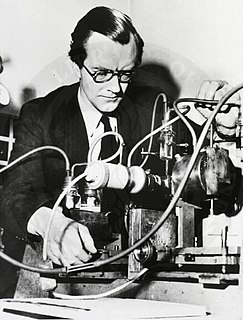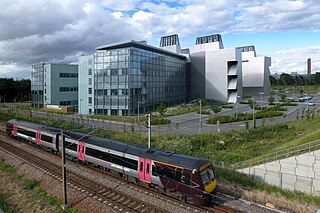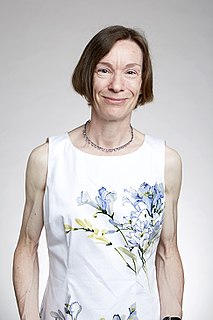Related Research Articles

GKT School of Medical Education is the medical school of King's College London. The school has campuses at three institutions, Guy's Hospital (Southwark), King's College Hospital and St Thomas' Hospital (Lambeth) in London – with the initial of each hospital making up the acronymous name of the school. University Hospital Lewisham and Queen Elizabeth Hospital are also teaching hospitals for GKT School of Medical Education. The school in its current guise was formed following a merger with the United Medical and Dental Schools of Guy's and St Thomas' Hospitals on 1 August 1998.

Maurice Hugh Frederick Wilkins was a New Zealand-born British biophysicist and Nobel laureate whose research spanned multiple areas of physics and biophysics, contributing to the scientific understanding of phosphorescence, isotope separation, optical microscopy and X-ray diffraction, and to the development of radar. He is best known for his work at King's College London on the structure of DNA.

The Medical Research Council (MRC) is responsible for co-coordinating and funding medical research in the United Kingdom. It is part of United Kingdom Research and Innovation (UKRI), which came into operation 1 April 2018, and brings together the UK's seven research councils, Innovate UK and Research England. UK Research and Innovation is answerable to, although politically independent from, the Department for Business, Energy and Industrial Strategy.

The Institute of Psychiatry, Psychology and Neuroscience (IoPPN) is a research institution dedicated to discovering what causes mental illness and diseases of the brain. In addition, its aim is to help identify new treatments for them and ways to prevent them in the first place. The IoPPN is a faculty of King's College London, England, previously known as the Institute of Psychiatry (IoP).

Hugh Esmor Huxley MBE FRS was a British molecular biologist who made important discoveries in the physiology of muscle. He was a graduate in physics from Christ's College, Cambridge. However, his education was interrupted for five years by the Second World War, during which he served in the Royal Air Force. His contribution to development of radar earned him an MBE.

The Medical Research Council (MRC) Laboratory of Molecular Biology (LMB) is a research institute in Cambridge, England, involved in the revolution in molecular biology which occurred in the 1950–60s. Since then it has remained a major medical research laboratory at the forefront of scientific discovery, dedicated to improving the understanding of key biological processes at atomic, molecular and cellular levels using multidisciplinary methods, with a focus on using this knowledge to address key issues in human health.

The Cambridge Biomedical Campus is the largest centre of medical research and health science in Europe. The site is located at the southern end of Hills Road in Cambridge, England. Over 20,000 people work at the site and is home to a number of organisations including: Cambridge University Hospitals NHS Foundation Trust, Royal Papworth Hospital NHS Foundation Trust, AstraZeneca's headquarters, Abcam, the Wellcome Trust, Cancer Research UK, the university's medical school, the UK government's Medical Research Council and has National Institute for Health Research Biomedical Research Centre status. It is an accredited UK academic health science centre.
Sir Philip Cohen FRS FRSE FMedSci is a British researcher, academic and Royal Medal winner based at the Medical Research Council Protein Phosphorylation and Ubiquitylation Unit, School of Life Sciences at the University of Dundee. During the 1990s he was the world's third most cited professor and has been described by Professor Garry Taylor of the University of St Andrews as "one of the world’s top scientists". and by Professor Sir Peter Downes as "arguably the UK's leading biochemist and an iconic figure in UK science". As of 2008 he has written over 470 peer-reviewed papers and given over 250 invited lectures in 33 countries, and has been repeatedly linked to a move of biotechnology companies to Dundee and the economic regeneration that came with it, to the point where 15% of the local economy is derived from biotech companies and their employees. His work has also seen Dundee attracting some of the world's best scientists, with over 1% of the world's most cited scientists residing in Dundee and fundraising of more than £35 million over the last 10 years to help attract them.
The Sir William Dunn School of Pathology is a department within the University of Oxford. Its research programme includes the cellular and molecular biology of pathogens, the immune response, cancer and cardiovascular disease. It teaches undergraduate and graduate courses in the medical sciences.
Thomas Dean Pollard is a prominent educator, cell biologist and biophysicist whose research focuses on understanding cell motility through the study of actin filaments and myosin motors. He is Sterling Professor of Molecular, Cellular & Developmental Biology and a Professor of Cell Biology and Molecular Biophysics & Biochemistry at Yale University. He was Dean of Yale's Graduate School of Arts and Sciences from 2010 to 2014, and President of the Salk Institute for Biological Studies from 1996 to 2001.
King's Health Partners is an academic health science centre located in London, United Kingdom. It comprises King's College London, Guy's and St Thomas' NHS Foundation Trust, King's College Hospital NHS Foundation Trust and South London and Maudsley NHS Foundation Trust.
Sir John Turton Randall, was an English physicist and biophysicist, credited with radical improvement of the cavity magnetron, an essential component of centimetric wavelength radar, which was one of the keys to the Allied victory in the Second World War. It is also the key component of microwave ovens.
The following outline is provided as an overview of and topical guide to biophysics:

Emmeline Jean Hanson was a biophysicist and zoologist known for her contributions to muscle research. Hanson gained her PhD in zoology from Bedford College, University of London before spending the majority of her career at a biophysics research unit at King's College London, where she was a founder member, and later its second Head. While working at Massachusetts Institute of Technology, she, with Hugh Huxley, discovered the mechanism of movement of muscle fibre in 1954, which came to known as "sliding filament theory". This was a groundbreaking research in muscle physiology, and for this BBC nicknamed her "Mrs Muscle" on the 50th anniversary of the discovery.

Sir James Cuthbert Smith is Director of Science at the Wellcome Trust and Senior Group Leader at the Francis Crick Institute.
Mary Katharine Levinge Collins is a British Professor of Immunology. She serves as Provost at the Okinawa Institute of Science and Technology in Japan. Formerly, Collins taught in the Division of Infection and Immunity at University College London, and was the head of the Division of Advanced Therapies at the National Institute for Biological Standards and Control, and the Director of the Medical Research Council Centre for Medical Molecular Virology. Her research group studies the use of viruses as vectors for introducing new genes into cells, which can be useful for experimental cell biology, for clinical applications such as gene therapy, and as cancer vaccines.
Robert Malcolm Simmons FRS was Director of the Medical Research Council Muscle and Cell Motility Unit from 1991 to 2003 and the Randall Division of Cell and Molecular Biophysics at King's College London from 1995 to 2001.

Anne Jacqueline Ridley is professor of Cell Biology and Head of School for Cellular and Molecular Medicine at the University of Bristol. She was previously a professor at King's College London.

The MRC Weatherall Institute of Molecular Medicine at the University of Oxford is a research institute located at the John Radcliffe Hospital in Oxford. Founded in 1989 by Sir David Weatherall, the institute focuses on furthering our understanding of clinical medicine at a molecular level. It was one of the first institutes of its kind in the world to be dedicated to research in this area.
Edwin W. Taylor is an American specialist in cytoskeleton and biochemical events of muscle contraction. An adjunct professor in the Department of Cell & Developmental Biology at Northwestern University, Taylor was elected to Membership of the National Academy of Sciences in 2001.
References
- ↑ "Our history". King's College London. Retrieved 5 March 2013.
